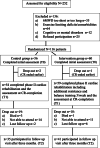The impact of additional resistance and balance training in exercise-based cardiac rehabilitation in older patients after valve surgery or intervention: randomized control trial
- PMID: 33413144
- PMCID: PMC7792183
- DOI: 10.1186/s12877-020-01964-3
The impact of additional resistance and balance training in exercise-based cardiac rehabilitation in older patients after valve surgery or intervention: randomized control trial
Abstract
Background: To evaluate the short- and mid-term effect of a specially tailored resistance and balance training provided in addition to usual cardiac rehabilitation (CR) care program in older patients after valve surgery/intervention.
Methods: Single-center (inpatient CR clinic in Lithuania) randomized controlled trial. Two hundred fifty-two patients were assessed for eligibility on the first day of admittance to CR early after (14.5 ± 5.9 days) valve surgery/intervention between January 2018 and November 2019. Participants were coded centrally in accordance with randomization 1:1 using a computerized list. Control group (CG) patients were provided with usual care phase-II-CR inpatient multidisciplinary CR program, while intervention group (IG) patients received additional resistance and balance training (3 d/wk). Patients participated in a 3-month follow-up. Main outcome measures were functional capacity (6 min walk test (6MWT, meters), cardiopulmonary exercise testing), physical performance (Short Physical Performance Battery (SPPB, score) and 5-m walk test (5MWT, meters/second)), strength (one repetition maximum test for leg press), physical frailty (SPPB, 5MWT).
Results: One hundred sixteen patients (76.1 ± 6.7 years, 50% male) who fulfilled the study inclusion criteria were randomized to IG (n = 60) or CG (n = 56) and participated in CR (18.6 ± 2.7 days). As a result, 6MWT (IG 247 ± 94.1 vs. 348 ± 100.1, CG 232 ± 102.8 vs. 333 ± 120.7), SPPB (IG 8.31 ± 2.21 vs. 9.51 ± 2.24, CG 7.95 ± 2.01 vs. 9.08 ± 2.35), 5MWT (IG 0.847 ± 0.31 vs. 0.965 ± 0.3, CG 0.765 ± 0.24 vs 0.879 ± 0.29) all other outcome variables and physical frailty level improved significantly (p < 0.05) in both groups with no significant difference between groups. Improvements were sustained over the 3-month follow-up for 6MWT (IG 348 ± 113 vs. CG 332 ± 147.4), SPPB (IG 10.37 ± 1.59 vs CG 9.44 ± 2.34), 5MWT (IG 1.086 ± 0. 307 vs CG 1.123 ± 0.539) and other variables. Improvement in physical frailty level was significantly more pronounced in IG (p < 0.05) after the 3-month follow-up.
Conclusion: Exercise-based CR improves functional and exercise capacity, physical performance, and muscular strength, and reduces physical frailty levels in patients after valve surgery/intervention in the short and medium terms. SPPB score and 5MWT were useful for physical frailty assessment, screening and evaluation of outcomes in a CR setting. Additional benefit from the resistance and balance training could not be confirmed.
Trial registration: NCT04234087 , retrospectively registered 21 January 2020.
Keywords: Cardiac rehabilitation; Exercise training; Physical frailty; TAVI; Valve surgery.
Conflict of interest statement
The authors declare that they have no competing interests.
References
-
- Schwaab B. Leitlinie zur kardiologischen Rehabilitation im deutschsprachigen Raum Europas, Deutschland, Österreich, Schweiz, vol. S3: Association of Scientific Medical Specialist Societies; 2019. Available from: www.awmf.org.
-
- Ambrosetti M, Abreu A, Corrà U, Davos CH, Hansen D, Frederix I, et al. Secondary prevention through comprehensive cardiovascular rehabilitation: From knowledge to implementation. 2020 update. A position paper from the Secondary Prevention and Rehabilitation Section of the European Association of Preventive Cardiology. Eur J Prev Cardiol. 2020. 10.1177/2047487320913379. - PubMed
-
- Bonow RO, Brown AS, Gillam LD, Kapadia SR, Kavinsky CJ, Lindman BR, et al. ACC/AATS/AHA/ASE/EACTS/HVS/SCA/SCAI/SCCT/SCMR/STS 2017 appropriate use criteria for the treatment of patients with severe aortic stenosis. J Am Coll Cardiol. 2017;70(20):2566–2598. doi: 10.1016/j.jacc.2017.09.018. - DOI - PubMed
-
- Sibilitz KL, Berg SK, Tang LH, Risom SS, Gluud C, Lindschou J, et al. Exercise-based cardiac rehabilitation for adults after heart valve surgery. Cochrane Database of Systematic Reviews. 2016. - PubMed
Publication types
MeSH terms
Associated data
LinkOut - more resources
Full Text Sources
Other Literature Sources
Medical
Research Materials


